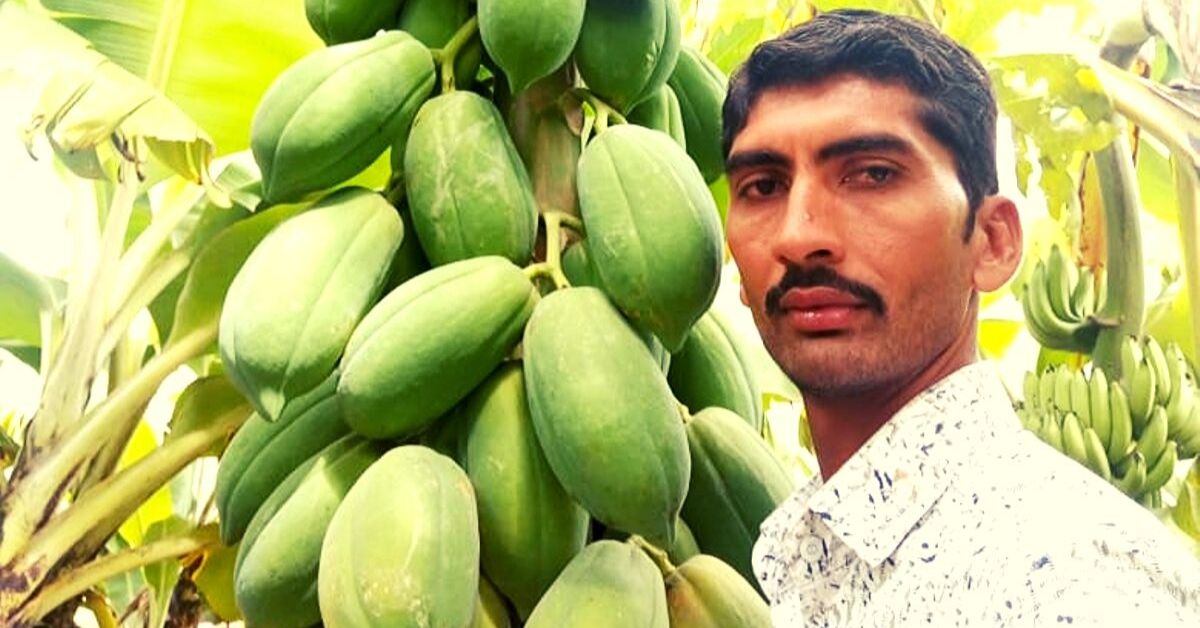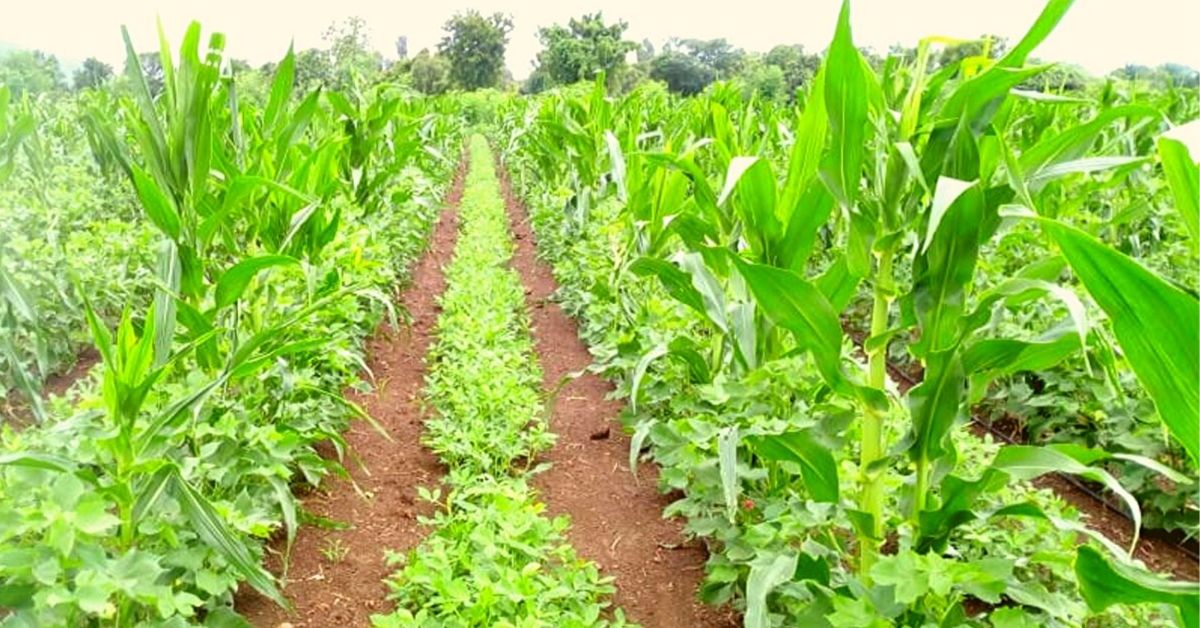Zero-Budget Natural Farming Doubles Gujarat Farmer’s Income In Just 6 Months!
What’s more? The water usage has come down by 70%, and in case of heavy rains, the crops won’t be damaged. Instead, the excess water will now recharge the groundwater table!

Vanrajsinh Gohil was born in 1988 in the Junavadar village of Gujarat’s Bhavnagar district and believes that his destiny was pre-decided.
“I was born in a farmer’s family and that is what I was expected to be,” he tells The Better India.
After completing his Higher Secondary Education in 2012, he joined the family’s cotton plantation. While he enjoyed his work, he was not content with the farming methods.
Grow your own organic food at home. Check out this mini hydroponic growing system that helps you grow your own vegetables, herbs, flowers and air cleaning plants wherever you like.
“Using chemicals and pesticides on the newly-born, nutritious plants did not feel right. I could see the difference in colour and structure of the crops post spraying. But none of my family members had any knowledge of a safe alternative,” he says.
With no other choice at his disposal, he continued using harmful chemicals to keep insects and pests away for the next couple of years.
However, destiny’s part was not over.

In 2016, he reconnected with his long lost friend, who is also a farmer, and when the two got talking, he expressed his displeasure with the use of chemicals and pesticides.
So, his friend introduced him to Subhash Palekar, an Indian agriculturist, who was awarded the a Padma Shri in 2016.
Fondly known as ‘Krishi ka Rishi,’ Palekar developed the concept of Zero Budget Natural Farming (ZBNF) or Subhash Palekar Natural Farming (SBNF) that requires almost no monetary investment.
The crops are grown naturally by replacing chemicals with eco-friendly fertiliser. You can read more about Palekar here.
A year later, Vanrajsinh registered for Palekar’s organic farming classes in Ahmedabad.
“I interacted with a lot of farmers at the 6-day training class whose stories inspired me to start from scratch. I acquired the farming knowledge from Palekar sir and now all I had to do was shift to natural farming,” he adds.
Developing A Model Farm

As anticipated, his family refused to even entertain the idea. Practising natural farming on their 40 bigha land was a strict no.
“They feared that the crops would be damaged in the absence of pesticides. Although it was hard for them to trust an amateur like me, my father agreed to let me experiment in a half-acre plot of land,” says the 31-year-old.
He applied the dual methods of multi-layer cropping and SBNF to grow vegetables and fruits. Multi-layer cropping optimises the use of land as more than two crops of varying heights are grown in close proximity.
Explaining the benefits, Vanrajsinh says, “The technique uses light and water more efficiently when compared to crops planted separately. This less distance also keeps insects at bay.”
He planted desi papaya seeds in the outer circle and Vegetables like brinjal, bitter gourd, turmeric, choli (beans), peanut, mung bean sprouts, cluster beans, sponge gourd and chillies in the inner circle.
He used dry leaves as a mulch instead of plastic sheets. Mulching is a gardening technique that suppresses weeds and conserves water in crop production. On the mulching sheet, he dug three feet deep holes at intervals where the seeds are sown.
“The deep holes prevent the crops from getting damaged during heavy rains. They absorb excess water and in turn recharge the groundwater,” he explains.
He also prepared jeevamrutham, a natural pesticide made from cow urine, dung and jaggery.
“I would use 200 litres once every 15 days, for the plot of land. As per Palekar’s observations, one gram of cow dung contains anything between 300 to 500 crore microorganisms, which decompose biomass on soil and convert it into nutrients for the plants. Not only does the pesticide ensure that insects do not damage the crops but it also improves soil fertility,” he says.
In addition to all this, Vanrajsinh has opted for the drip irrigation method to water the crops, and that has reduced the usage of water by 70 per cent.
Reaping the Benefits
Six months after incorporating the SPNF model, Vanrajsinh harvested the vegetables and hired two people who opened a small stall in the market in Palitana, a small town in his district, to sell them.
Even though he increased the rates of vegetables by 30 per cent of the current market rate, he marketed the vegetables as healthy and 100 per cent natural and thanks to his marketing skills, all the vegetables were sold in a week.
Next, he formed a WhatsApp group of customers who were willing to purchase the produce from his farm.
“I would send a message on the group once the vegetables left from the farm so that they could buy them when they were fresh,’ he says.
For the next three months, Vanrajsinh continued the process and then decided to shift the focus to the cotton plantation.
His regular customers soon started missing the fresh produce and demanded that he re-open the stall and also bring other vegetables besides the ones he was growing on his farm.
“I was stunned to see the effect of natural farming. Without wasting any time, I got in touch with other farmers in the village who were producing other vegetables organically. I collaborated with two other farmers and re-opened the stall,” he says.
Over a period of time, the yield, customers and Vanrajsinh’s income increased.
“I made a profit of Rs 2 lakh in 6-8 months. My family members also came on board after seeing the success of the model farm,” he says.
Despite its success, Vanrajsinh confesses that SPNF gave him a hard time, in the beginning.
“I used to spend my entire day on the farm studying the progress of the crops and effects of spraying jeevamrutham. Some of the seeds even failed, but that helped me learn about the behaviour patterns of plants. After a period of time, the seeds got used to natural fertiliser. I highly recommend this method to every farmer.”
Banking on the success of organic farming, he is now implementing the budget farming technique to grow cotton in his family’s land, in addition to growing vegetables and fruits the half acre plot, “We will get the results in the next few months, and I am positive about it.”
He is also working on his newly formed YouTube channel, where will post videos about his farming methods, “I want other farmers also to adopt the technique, but not everyone has the time to attend the training by Palekar sir. So, I will give them free classes through YouTube.”
If you wish to get in touch with Vanrajsinh Gohil, write to him at [email protected]
Also Read: Haryana Engineer Scripts Success in Zero-Budget Natural Farming!
(Edited by Gayatri Mishra)
Like this story? Or have something to share?
Write to us: [email protected]
Connect with us on Facebook and Twitter.
This story made me
-
97
-
121
-
89
-
167
Tell Us More
We bring stories straight from the heart of India, to inspire millions and create a wave of impact. Our positive movement is growing bigger everyday, and we would love for you to join it.
Please contribute whatever you can, every little penny helps our team in bringing you more stories that support dreams and spread hope.



















